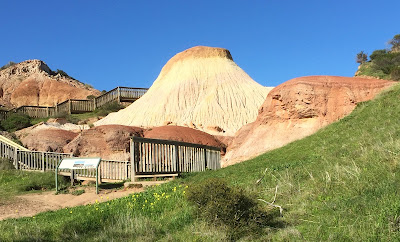At a first glance it all seemed fairly ordinary - undulating hills covered with clumps of bushes and trees, a band of eroded rock encircling the area, a creek, a gully leading to the beach, and a rocky shoreline.
But interpretive signs along the way told a different story. I was soon fascinated by the information I was reading, though I must admit I can never get my head around dates such as '280 million years ago' and the various ages such as Precambrian, Pleistoscene and Permian ...
It turns out that this is one of the best known geological sites in Australia. There is evidence of an Australian ice age giving it international significance, Aboriginal occupation, and loads of uplifts, erosion, rising and lowering of sea levels over the ages. It's even been declared a Geological Monument and is on the SA Heritage Register. I had no idea.
Our first stop on the path led us to a formation called the Sugarloaf, so named because it apparently resembles a hill of hard packed sugar. Hmmm.
Here's a closer look.
Encircling the whole area is the Amphitheatre, and I accept that this name is fairly appropriate.
It shows evidence of the constant changing of the land due to uplifts and erosion over the millenia.
Leaving these fascinating formations, we continued on our way. Perhaps the Sugrloaf does look like a lump of hard-packed sugar after all.
The walk was so easy and interesting I was really enjoying myself. Looking back we could see the curve of the beach and the houses at Hallett Cove in the distance.
We kept stopping to read the interpretive boards or look at the vegetation.
These chocolate coloured rocks are apparently the oldest rocks exposed in the park. Who would have thought? That's why I love interpretive signs!
And then we came upon evidence of glacial activity millenia ago. The glacial pavements (as they are called) clearly show the scratches left by boulders as they were pushed along by the glacier. According to the sign they are recognised as the best record of Permian glaciation in Australia and are internationally significant. So there!
We continued on, trying to visualise the area 270 million years ago.
These rocks looked pretty ordinary until I read the sign that said they were remnants of the sea floor four million years ago, and were only uplifted around two million years ago. At least that's a little more recent.
We had reached the end of the walk, so retraced our steps along the boardwalk, marvelling at our trip back in time.
An afternoon tea stop at the Yankallila bakery convinced us we were well and truly in the 21st century.
















I love seeing South Australia through your eyes. When I was at school the only reason you went to Hallet's Cove was as part of a geology excursion to see this large rock on the roadside with a plaque about fossils. That's all that was there - no walk, no interpretation signs, no houses. We dismiss it now because it is all houses. I'll have to stop and retrace your steps sometime...
ReplyDeleteXXXX